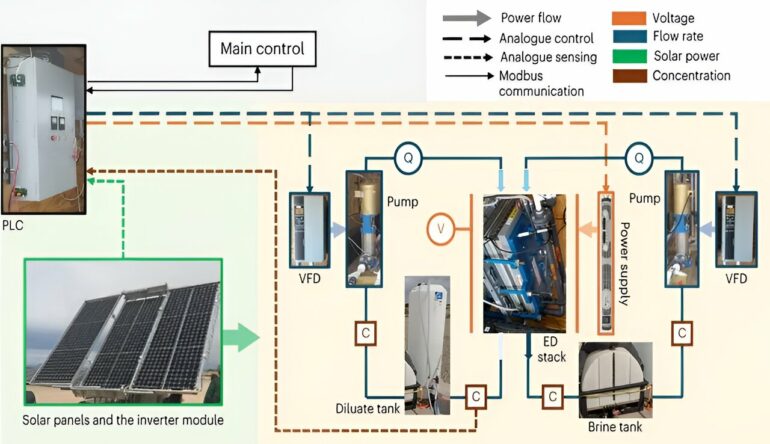Scientists have developed a new solar-powered system to convert saltwater into fresh drinking water which they say could help reduce dangerous waterborne diseases like cholera.
In a paper published today in Nature Water, researchers show that the process is more than 20% cheaper than traditional methods and can be deployed in rural locations around the globe. Following testing in rural communities, they found new technology could signal a step change in providing clean water in developing countries and beyond.
Building on existing processes that convert saline groundwater to freshwater, the researchers from King’s College London, in collaboration with MIT and the Helmholtz Institute for Renewable Energy Systems, created a new system that produced consistent levels of water using solar power.
It works by separating the salt using a set of specialized membranes that channel salt ions into a stream of brine, leaving the water fresh and drinkable. By flexibly adjusting the voltage and the rate at which salt water flowed through the system, the researchers developed a system that adjusts to variable sunshine while not compromising on the amount of fresh drinking water produced.
Using data first gathered in the village of Chelleru near Hyderabad in India, and then recreating these conditions of the village in New Mexico, the team successfully converted up to 10 m3 of fresh drinking water. This was enough for 3,000 people a day—with the process continuing to run regardless of variable solar power caused by cloud coverage and rain.
Dr. Wei He from King’s College London’s Department of Engineering believes the new technology could bring massive benefits to rural communities, not only increasing the supply of drinking water but also bringing health benefits.
He said, “By offering a cheap, eco-friendly alternative that can be operated off the grid, our technology enables communities to tap into alternative water sources (such as deep aquifers or saline water) to address water scarcity and contamination in traditional water supplies.
“This technology can expand water sources available to communities beyond traditional ones and by providing water from uncontaminated saline sources, may help combat water scarcity or unexpected emergencies when conventional water supplies are disrupted, for example like the recent cholera outbreaks in Zambia.”
Roughly, a quarter of the world’s population face “extremely high” levels of water stress, which leads to a high likelihood of water scarcity. In the global rural population 1.6 billion people face water scarcity, many of whom are reliant on stressed reserves of groundwater lying beneath the Earth’s surface.
However, worldwide 56% of groundwater is saline and unsuitable for consumption. This issue is particularly prevalent in India, where 60% of the land harbors undrinkable saline water. Consequently, there is a pressing need for efficient desalination methods to create fresh drinking water cheaply, and at scale.
Traditional desalination technology has relied either on costly batteries in off-grid systems or a grid system to supply the energy necessary to remove salt from the water. In developing countries’ rural areas, the grid infrastructure can be unreliable and is largely reliant on fossil fuels.
Without regular supplies of energy at use, individual villages and communities must rely on expensive batteries to use renewable energy like solar to provide their fresh water, passing the cost onto individual consumers.
Creating a low-cost “battery-like” desalination technology removes the reliance on battery technology for using intermittent solar energy in off-grid applications, enabling affordability to rural communities in developing countries like India.
Dr. He added, “Traditionally, desalinating water has been energy-intensive and costly, confining its use to areas with stable power and financial resources. By removing the need for a grid system entirely and cutting reliance on battery tech by 92%, our system can provide reliable access to safe drinking water, entirely emission free onsite and at a discount of roughly 22% to the people who need it compared to traditional methods.”
The system also has the potential to be used outside of developing areas, particularly in agriculture where climate change is leading to unstable reserves of fresh water for irrigation.
The team plan to scale up the availability of the technology across India through collaboration with local partners. Beyond this, a team from MIT also plan to create a start-up to commercialize and fund the technology.
Dr. He said, “Fresh water for irrigation is a large problem in across the globe, including North America, the Middle East, and Sub-Saharan Africa. Drought and cost are major draws on an industry which relies on unstable reserves of water to survive, and climate change will further exacerbate these challenges.
“By providing a sustainable way for farmers to produce freshwater for irrigation at a cut price without its volume being compromised, we can help them reduce costs, mitigate carbon emissions, and ensure agriculture production and eventually pass those benefits onto consumers.
“While the U.S. and U.K. have more stable, diversified grids than most countries, they still rely on fossil fuels. By removing fossil fuels from the equation for energy hungry sectors like agriculture, we can help accelerate the transition to Net Zero.
“The next step for us is to apply this low-cost technology to other sectors, including wastewater treatment, and producing alkaline to make the ocean more alkaline to help it absorb more CO2 from the atmosphere. By taking this approach not only can we decarbonize agriculture, but wider environmental and climate benefits as well.”
More information:
Wei He et al, Flexible batch electrodialysis for low-cost solar-powered brackish water desalination, Nature Water (2024). DOI: 10.1038/s44221-024-00213-w
Provided by
King’s College London
Citation:
Solar-powered emission-free technology converts saltwater into drinking water (2024, March 27)



